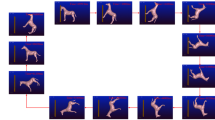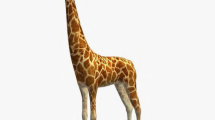Abstract
Eigenfunctions and eigenvalues of physical systems and engineering structures can reveal many of the system’s fundamental features and, therefore, become a basis for the study of inverse problems. In this series of papers, we take a reverse, direct-problem point of view; namely, given the shapes of animals, can we see the patterns of their motions or behaviors through their eigenmode analysis? This modal analysis, we believe, has never been done for living animals. Our modal analysis emphasizes dynamics, which is achieved by visualization through video animation by incorporating the time-harmonic dependence of the eigenmodes. Furthermore, we intend our modal analysis to be more realistic by encompassing the situation of the presence of a floor. Certain physical interpretations of the motion patterns from modal analysis are made. In addition, by visualization, one can see that symmetry plays an important role in motion patterns. One of our main conclusions is that shapes alone can usefully reflect or explain some animal’s behavior or motion patterns.














































































Similar content being viewed by others
References
Kac, M.: Can one hear the shape of a drum? Am. Math. Mon. 73(4P2), 1–23 (1966)
Gordon, C., Webb, D.L., Wolpert, S.: One cannot hear the shape of a drum. Bull. Am. Math. Soc. 27(1), 134–138 (1992)
Zelditch, S.: Spectral determination of analytic bi-axisymmetric plane domains. Geom. Funct. Anal. 10(3), 628–677 (2000)
Animals, see the website of Biology Online. https://www.biologyonline.com/dictionary/animal
Thompson, D.W., Thompson, D.W.: On Growth and Form, vol. 2. Cambridge University Press, Cambridge (1942)
Allometry. https://en.wikipedia.org/wiki/Allometry/
Vitalism. https://en.wikipedia.org/wiki/Vitalism/
Turing, A.M.: The chemical basis of morphogenesis. Bull. Math. Biol. 52(1), 153–197 (1990)
Wu, J., Qiu, Y.: Modelling of seated human body exposed to combined vertical, lateral and roll vibrations. J. Sound Vib. 485, 115509 (2020)
Yue, Z., Mester, J.: A modal analysis of resonance during the whole-body vibration. Stud. Appl. Math. 112(3), 293–314 (2004)
van der Weele, J.P., Banning, E.J.: Mode interaction in horses, tea, and other nonlinear oscillators: the universal role of symmetry. Am. J. Phys. 69(9), 953–965 (2001)
Banning, E., Van der Weele, J.: Mode competition in a system of two parametrically driven pendulums: the Hamiltonian case. Physica A 220(3–4), 485–533 (1995)
Banning, E., Van der Weele, J., Ross, J., Kettenis, M.: Mode competition in a system of two parametrically driven pendulums with nonlinear coupling. Physica A 245(1–2), 49–98 (1997)
Banning, E., Van der Weele, J., Ross, J., Kettenis, M., de Kleine, E.: Mode competition in a system of two parametrically driven pendulums; the dissipative case. Physica A 245(1–2), 11–48 (1997)
Banning, E., Van der Weele, J., Kettenis, M.: Mode competition in a system of two parametrically driven pendulums; the role of symmetry. Physica A 247(1–4), 281–311 (1997)
Van der Weele, J., Banning, E.: Mode interaction in a cup of coffee and other nonlinear oscillators. Nonlinear Phenom. Complex Syst. 3(3), 268–283 (2000)
Chen, G., Scully, M.M., Huang, J., Sergeev, A., Yang, J., Wei, C.-Q., Monday, P., Cohen, L., Cheng, X.-G., Liu, S.-Y., Wang, J., Zhou, S.-Q.: Fundamental biomechanical modes of motion of the human body as human vibration
Ciarlet, P.G.: The Finite Element Method for Elliptic Problems. SIAM, Philadelphia (2002)
LSTC, LS-DYNA Theory Manual. https://ftp.lstc.com/anonymous/outgoing/jday/manuals/DRAFT_Theory.pdf/
Korn, A.: Solution générale du problème d’équilibre dans la théorie de l’élasticité, dans le cas ou les efforts sont donnés à la surface, Annales de la Faculté des sciences de Toulouse. Mathématiques 10, 165–269 (1908)
CAD horse model. https://blendermarket.com/products/horse-base-mesh
SolidWorks software package. https://my.solidworks.com/
ANSYS Geometry. https://grabcad.com/library?sort=most_downloaded &tags=ansys
Blender software (Home of the Blender project-Free and Open 3D artistic rendering and movie-making software platform). https://www.blender.org/
LSTC, Contact Modeling in LS-DYNA. https://www.dynasupport.com/tutorial/ls-dyna-users-guide/contact-modeling-in-ls-dyna
Dziri, R.: Optimal tubes for non-cylindrical Navier–Stokes flows with Navier boundary condition. Evol. Equ. Control Theory 12(3), 1014–1038 (2023)
Ganghoffer, J.-F., Plotnikov, P.I., Sokolowski, J.: Nonconvex model of material growth: mathematical theory. Arch. Ration. Mech. Anal. 230, 839–910 (2018)
Plotnikov, P.I., Ganghoffer, J., Sokolowski, J.: Volumetric Material Growth: Mathematical Theory, Doklady Mathematics, vol. 94, pp. 498–501. Springer, Cham (2016)
Ganghoffer, J.-F., Plotnikov, P.I., Sokołowski, J.: Mathematical modeling of volumetric material growth in thermoelasticity. J. Elast. 117, 111–138 (2014)
Moubachir, M., Zolesio, J.-P.: Moving Shape Analysis and Control: Applications to Fluid Structure Interactions. CRC Press, Boca Raton (2006)
Acknowledgements
We thank Prof. Jan Sokolowski for invaluable suggestions and constructive comments. Chunqiu Wei is supported by the Research Ability Improvement Program for Young Teachers of BUCEA (Grant No. X21031). Tiexin Guo is supported by the National Natural Science Foundation of China (Grant No. 11971483) and the Science and Technology Research Project of Chongqing Municipal Education Commission (Grant No. KJ1706154). Pengfei Yao is supported in part by the National Science Foundation of China, grant No. 12071463, and by the special fund for Science and Technology Innovation Teams of Shanxi Province, Grants # 202204051002015. Junmin Wang is supported in part by the National Natural Science Foundation of China No. 62073037 and 12131008.
Author information
Authors and Affiliations
Corresponding author
Additional information
Publisher's Note
Springer Nature remains neutral with regard to jurisdictional claims in published maps and institutional affiliations.
G. Chen: on Development Leave from Texas A &M University.
Appendix: Frequencies of vibrations of the horse and camel
Appendix: Frequencies of vibrations of the horse and camel
Rights and permissions
Springer Nature or its licensor (e.g. a society or other partner) holds exclusive rights to this article under a publishing agreement with the author(s) or other rightsholder(s); author self-archiving of the accepted manuscript version of this article is solely governed by the terms of such publishing agreement and applicable law.
About this article
Cite this article
Chen, G., Huang, J., Wei, C. et al. Animal Shapes, Modal Analysis, and Visualization of Motion (I): Horse and Camel. J Geom Anal 33, 328 (2023). https://doi.org/10.1007/s12220-023-01339-1
Received:
Accepted:
Published:
DOI: https://doi.org/10.1007/s12220-023-01339-1




